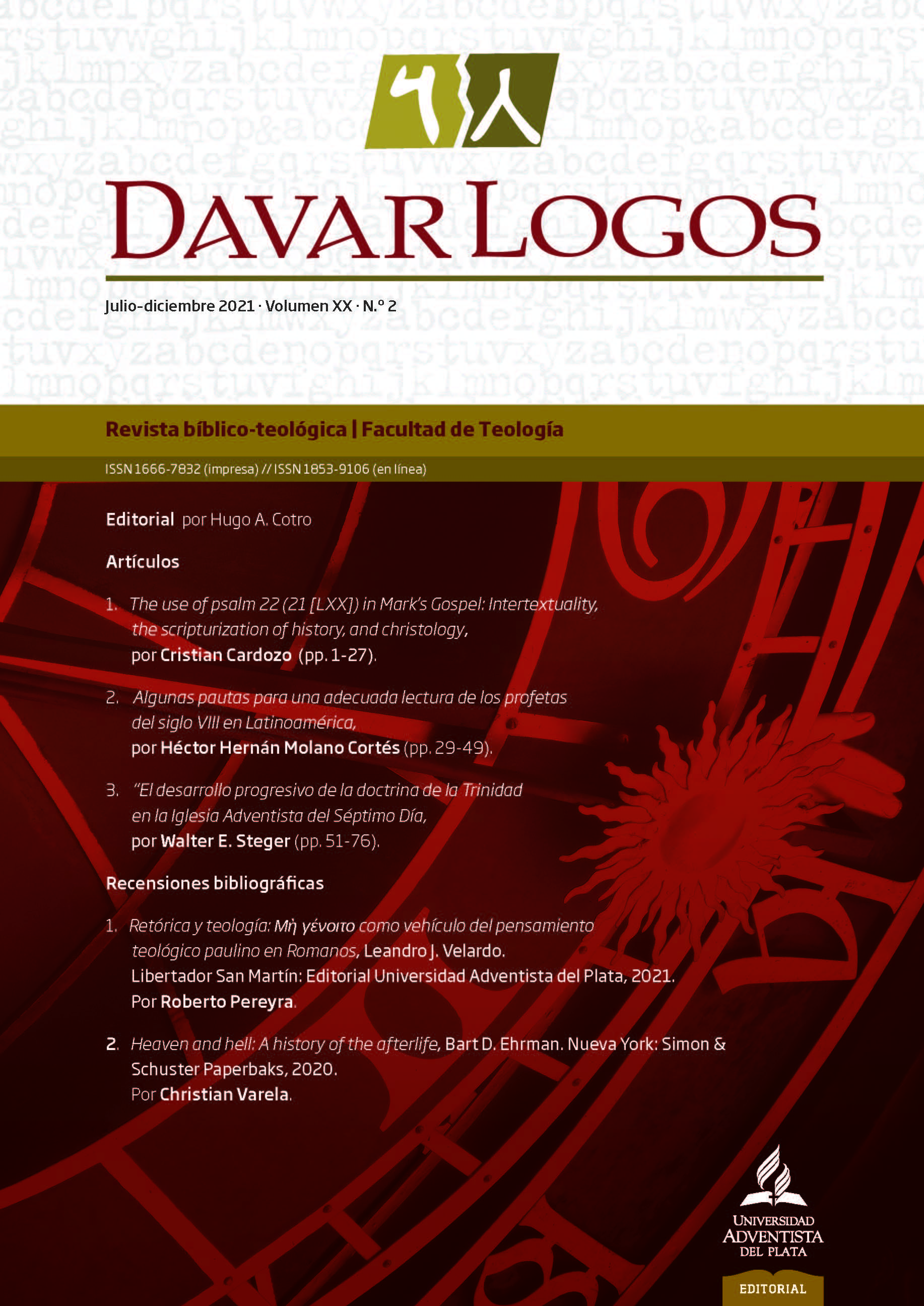El desarrollo progresivo de la doctrina de la Trinidad en la Iglesia Adventista del Séptimo Día
DOI:
https://doi.org/10.56487/678ab480Palabras clave:
Deidad — Trinidad — Desarrollo doctrinal — Iglesia Adventista del Séptimo DíaResumen
Los pioneros de la Iglesia Adventista del Séptimo Día en su mayoría rechazaron la doctrina de la Trinidad durante las primeras décadas de la historia de la denominación. Este artículo realiza un rastreo y análisis de las principales declaraciones en la literatura adventista entre 1844 y 1900, demostrando el desarrollo progresivo de la doctrina de la Trinidad y las razones para su rechazo inicial y posterior aceptación. Se analiza también el papel de Ellen G. White en ese desarrollo doctrinal y algunas posibles explicaciones para el lento proceso de aceptación de la doctrina de la Trinidad.
Descargas
Referencias
Ver Erwin Roy Gane, “The Arian or anti-trinitarian views presented in Seventh-day
Adventist literature and the Ellen G. White answer” (tesis de maestría, Andrews University,
Berrien Springs, Michigan, 1963).
Estos incluyen pero no se limitan a: Merlin D. Burt, “Demise of semi-Arianism and anti-trinitarianism
in Adventist theology, 1888-1957” (Andrews University, 1996); Jerry Moon, “The
Adventist Trinity debate part 1: Historical overview”, Andrews University Seminary Studies 41,
n. º 1 (2003): 113-129; Jerry Moon, “The Adventist Trinity debate part 2: The role of Ellen G.
White”, Andrews University Seminary Studies 41, n.o 2 (2003): 275-292; Merlin D. Burt, “History
of Seventh-day Adventist views on the Trinity”, Journal of the Adventist Theological Society
, n.º 1 (primavera de 2006): 125-139; Gerhard Pfandl, “The doctrine of the Trinity among
Seventh-day Adventists”, Journal of the Adventist Theological Society 17, n. º 1 (2006): 160-179.
Quien hace esta observación pertinente es Kai Arasola. Ver Kai Arasola, “Historical reflections
on early Adventist anti-Trinitarianism”, Catalyst 3, n. º 1 (noviembre de 2008): 46-61.
“Fifteenth meeting, General Conference report No. 8”, The Advent Review and Sabbath Herald,
de junio de 1946, 197.
Himes, “Christian connection”, en Encyclopedia of religious knowledge, 363. Si bien Himes no
llegó a formar parte del movimiento adventista sabatario, lo incluimos aquí por pertenecer a la
Conexión Cristiana y sostener las mismas ideas que James White y Joseph Bates sobre la Deidad.
James White, “Letter from Bro. White”, 25.
James White, “The faith of Jesus”, 52.
Stephenson, The atonement, 133.
J. B. Frisbie, “The Trinity”, 146.
J. N. Loughborough, “Questions for Bro. Loughborough”, 184.
D. M. Canright, “Jesus Christ the Son of God”, 1.
James White, Life incidents (Battle Creek, MI.: Seventh-day Adventist Publishing Assoc.,
, 343.
Ellen G. White, Testimony for the Church − No. 17 (Steam Press of the Seventh-Day Adventist
Publishing Association, 1869), 1. En este artículo, las citas de Ellen G. White han sido colocadas
en inglés según su publicación original, a pesar de que muchas fueron traducidas al español
posteriormente, a fin de facilitar la comparación del lenguaje con las declaraciones de sus
contemporáneos.
Ellen G. White, “The first advent of Christ”, The Advent Review and Sabbath Herald, 17 de
diciembre de 1872, 2.
James White, “The two bodies”, The Advent Review and Sabbath Herald, 12 de octubre de
, 116.
Ellen G. White, “An appeal to the ministers”, The Advent Review and Sabbath Herald, 8 de agosto
de 1878, 49.
Ellen G. White, “Letter 37, 1887”, en Manuscript releases, vol. 15 (Silver Spring, MD:
Ellen G. White Estate, 1990), 25-26.
Ellen G. White, The great controversy (Oakland, CA: Pacific Press Publishing Company,
, 493.
Waggoner, Christ and his righteousness, 44.
Samuel T. Spear, The Bible doctrine of the Trinity, The Bible Students Library 90 (Oakland, CA:
Pacific Press Publishing Company, 1892), 3-14, citado en Moon, “The Adventist Trinity debate
part 1: Historical overview”, 119-120.
G. C. Tenney, “To correspondents”, The Advent Review and Sabbath Herald, 9 de junio de
, 362.
Ellen G. White, “Letter 8, 1896”, en The Ellen G. White 1888 materials (Washington, DC:
Ellen G. White Estate, 1987), 1493.
Ellen G. White, “Christ the life-giver”, The Signs of the Times, 8 de abril de 1897, 6.
Smith, Looking unto Jesus, 17.
R. A. Underwood, “The Holy Spirit a person”, 310.
Alonzo T. Jones, “Editorial”, Advent Review and Sabbath Herald, 10 de enero de 1899, 24.
Ellen G. White, “Resistance to light − No. 3”, The Signs of the Times, 29 de agosto de 1900.
Ver Richard Rice, Reign of God: An introduction to Christian theology from a Seventh-Day
Adventist perspective, 2. ª ed. (Berrien Springs, MI: Andrews University Press, 1997), 9.
Asociación General de los Adventistas del Séptimo Día, Manual de la iglesia (Buenos Aires:
Asociación Casa Editora Sudamericana, 2015), 158. Esta frase ha sido incluida como preámbulo
de la declaración de creencias fundamentales en el Manual de la iglesia desde 1981.
Ver Church manual (The General Conference of Seventh-day Adventists, 1981), 31.
Ver Fritz Guy, Thinking theologically: Adventist Christianity and the interpretation of faith (Berrien
Springs, MI: Andrews University Press, 1999), 75. Guy hace un análisis completo del desarrollo
doctrinario adventista en las páginas 65-93.
White, “The Word”, 149.
Rolf J. Pöhler, “Change in Seventh-day Adventist theology: A study of the problem of doctrinal
development” (tesis de doctorado en Teología, Andrews University, Berrien Springs, Michigan,
, 164.
Ellen G. White, “Letter 156 to P. T. Magan”, 27 de julio de 1903.
Richard W. Schwarz, Portadores de luz: historia de la Iglesia Adventista del Séptimo Día (Buenos
Aires: Asociación Casa Editora Sudamericana, 2002), 53, 67, 68.
George R. Knight, “Adventists and change”, Ministry 66, n.o 10 (octubre de 1993): 12.
Ver Le Roy Edwin Froom, Movement of destiny (Washington, DC: Review and Herald Pub.
Association, 1971).
Guy, Thinking theologically, 87.
Ver, por ejemplo, Bates, The autobiography of Elder Joseph Bates, 205; White, “The faith of Jesus”,
; Hull, “Bible doctrine of the divinity of Christ”, 10 de noviembre de 1859, 193; Gage, “Popular
errors and their fruits, No. 3”, 101; Canright, “Jesus Christ the Son of God”, 1.
Ver Wilcox, “The message for today”, 21; 1931 Year book of the Seventh-day Adventist denomination,
; Church manual, 1932, 180.
White, “Letter from Bro. White”, 25; Frisbie, “The Seventh day-Sabbath not abolished”, 50;
Frisbie, “The Trinity”, 146; Hull, “Bible doctrine of the divinity of Christ”, 10 de noviembre de
, 193; Whitney, “Both sides: Reply to the foregoing letter”, 110; Canright, “The personality
of God”, 29 de agosto de 1878.
Ver Ellen G. White, Early writings (Washington, DC: Review and Herald Publishing Association,
, 54.
Ver White, Life incidents, 343; White, “Christ equal with God”, 172; Loughborough, “Questions
for Bro. Loughborough”, 184. Lo irónico aquí es que los pioneros insistían a su vez en la
divinidad de Cristo, aunque enfatizando su distinción e inferioridad al Padre. En ese caso aceptaban
dos “Dioses”, aunque uno subordinado al otro, pero no estaban dispuestos a aceptar “tres
Dioses”.
White, “Letter from Bro. White”, 25; Frisbie, “The Seventh day-Sabbath not abolished”, 50;
Hull, “Bible doctrine of the divinity of Christ”, 10 de noviembre de 1859, 193; Loughborough,
“Questions for Bro. Loughborough”, 184.
Por un tratamiento más profundo de este tema, ver Agenilton Corrêa, “An approach on the
doctrine of the Trinity in Seventh-day Adventist theology and Roman Catholic theology”,
DavarLogos 17, n. º 2 (2018): 61-102.
James White, “Christian union”, The Advent Review and Sabbath Herald, 12 de octubre de
, 116.
Ibíd.
James White, “The two bodies”, The Advent Review and Sabbath Herald, 12 de octubre de
, 116.
Ver Uriah Smith, A declaration of the fundamental Principles Taught and Practiced by the Seventh-
day Adventists (Battle Creek, MI: SDA Publishing Association, 1872); “Fundamental
Principles of Seventh-day Adventists”, en Seventh-day Adventist Yearbook (1889), 147.
Ver Canale, “Dios”, en Tratado de teología adventista del séptimo día, 170-172. Según Canale,
“el rechazo de la interpretación teológica clásica de la doctrina de la Trinidad por parte de algunos
autores adventistas no supone necesariamente un rechazo de la revelación bíblica sobre la
Trinidad, porque ellos rechazan la interpretación, no los hechos en sí. [...] Así, algunos pioneros
adventistas entendieron que la interpretación clásica de la Trinidad inmanente era incompatible
con la Trinidad ‘económica’ según está presentada en las Escrituras” (ibíd., 170). Luego, agrega
que la nueva comprensión de la Deidad por parte de la denominación “señaló el necesario abandono
de la doctrina clásica, [...] que involucraba la subordinación eterna, ontológica, del Hijo”
(ibíd., 171).
Ver George R Knight, Nuestra identidad: origen y desarrollo (Miami, FL: Asociación Publicadora
Interamericana, 2007), 70.
Merlin D. Burt, “El centro del ministerio profético de Elena G. de White”, en El don de profecía
en las Escrituras y en la historia, ed. Alberto R. Timm y Dwain N. Esmond (Miami, FL: Asociación
Publicadora Interamericana, 2016), 374.
Ibíd., 375.
Ellen G. White, “An appeal to the ministers”, The Advent Review and Sabbath Herald, 8 de agosto
de 1878, 49.
“Adventists hold the divinity of Christ so nearly with the trinitarian, that we apprehend no trial
here” ( James White, “The two bodies”, The Advent Review and Sabbath Herald, 12 de octubre
de 1876, 116).
En ese artículo James afirmó: “We may look upon the Father and the Son before the worlds were
made as a creating and law administering firm of equal power. Christ did not then rob God in
regarding himself equal with the Father” (White, “Christ equal with God”, 172). De hecho, argumentó
también que la subordinación del Hijo sucedió únicamente en su encarnación. Si bien
probablemente aún no aceptaba la preexistencia eterna del Hijo, estaba muy cerca de la postura
trinitaria bíblica que años después sería aceptada por la iglesia.
Ellen G. White, “Letter 8, 1896”, en The Ellen G. White 1888 materials (Washington, DC:
Ellen G. White Estate, 1987), 1493.
Ellen G. White, “Christ the life-giver”, The Signs of the Times, 8 de abril de 1897, 6.
Ver Waggoner, Christ and his righteousness, 44; Jones, “The third angel’s message number 17”,
; Jones, “The third angel’s message number 20”, 382.
Wheeler, “The communion of the Holy Spirit”, 244; Jones, “The third angel’s message number
”, 329.
Spear, The Bible doctrine of the Trinity.
Burt, “El centro del ministerio profético de Elena G. de White”, 375.
Burt, “History of Seventh-day Adventist views on the Trinity”, 129.
“Report of the 1919 Bible Conference” ( July 6, 1919), 58, cit. en Pfandl, “The Doctrine of the
Trinity among Seventh-day Adventists”, 172.
Ver, por ejemplo: Daniel Bernhardt, “Dios revelado en las Escrituras: estudio sobre la divinidad”,
ª ed. (documento inédito, septiembre de 2009); Cristian Silva, “La apostasía Alfa y Omega.
El Alfa ya es historia. La Omega... está viva y en su apogeo” (documento inédito, 2008); Gabriel
G. Geier, “La Deidad verdadera” (documento inédito, revisión 2010).
Ellen G. White, Special testimonies, Series B (1905), 7:63.
Ver Moon, “The Adventist Trinity debate part 2: The role of Ellen G. White”, 291.
Ver Fortin y Moon, The Ellen G. White encyclopedia, 19-28; y “The articles of religion of the
Methodist Church” (1808), en The book of discipline of the United Methodist Church, 2016, 65.
“I saw a throne, and on it sat the Father and his Son Jesus Christ. I gazed on Jesus’ countenance
and admired his lovely person. The Father’s person I could not behold for a cloud of glorious
light covered him. I asked Jesus if his Father had a form like himself; He said he had, but I could
not behold it; for, said he, if you should for once see the glory of his person, you would cease to
exist” (Ellen G. White, “Letter from Sister Harmon”, The Day-Star, 14 de marzo de 1846).
Entre los errores introducidos que sí menciona Ellen G. White, se encuentran la adoración de
imágenes y reliquias, el domingo como día de reposo, el papa como mediador entre Dios y los
hombres, la salvación por obras, la inmortalidad del alma, la veneración de la virgen María y
los santos, el infierno como lugar de tormento eterno y el purgatorio y la transubstanciación
del pan y del vino (ver Ellen G. White, The great controversy (Mountain View, CA: Pacific
Press Publishing Association, 1911), 49-60.
Ver Jerry Moon, “Heresy or hopeful sign? Early Adventists’ struggle with the truth about the
Trinity”, Adventist Review, 22 de abril de 1999, 11-12.
Ver Knight, “Adventists and change”, 12; Moon, “Heresy or hopeful sign? Early Adventists’ struggle
with the truth about the Trinity”, 12. Con respecto a los que deseaban imponer la abstención
de la carne de cerdo como prueba de discipulado, Ellen G. White escribió en 1858: “As the
angel leads them, they get in haste for something new, and rush on without divine guidance, and thus bring confusion and discord into the ranks” (Ellen G. White, Testimonies for the Church,
vol. 1 [Mountain View, CA: Pacific Press Publishing Association, 1868], 207).
White, Testimonies for the Church, 1:207.
Corrêa, “An approach on the doctrine of the Trinity in Seventh-day Adventist theology and
Roman Catholic theology”, 71, 72.
Ibíd., 72.
Fernando L. Canale, Elementos básicos de la teología cristiana (Libertador San Martín: Editorial
Universidad Adventista del Plata, 2017), 70.
Corrêa, “An approach on the doctrine of the Trinity in Seventh-day Adventist theology and
Roman Catholic theology”, 75, 76.
Canale, Elementos básicos de la teología cristiana, 77, 84. Los padres de la Iglesia entendieron los
textos que hablan de Cristo como engendrado ( Jn 1,18; Hb 1,5-6; etc.) de manera literal, y los
aplicaron a la relación de realidad que existe entre el eterno Padre y el Hijo eterno. “En otras
palabras, cambiaron el significado de las palabras en su contexto histórico-bíblico al contexto
atemporal donde se suponía que existían las entidades eternas del Padre atemporal y el Hijo atemporal” (ibíd., 77). Lo mismo interpretaron de Juan 15,26 con respecto a la “procedencia”
del Espíritu Santo (ibíd., 84, 85).
Johnson, “Appendix: The Trinity in the Bible and selected creeds of the Church”, 176, 177.
Ver Philip Schaff, The creeds of Christendom: With a history and critical notes, vol. 3 (Grand Rapids,
MI: Baker Book House, 1977), 738.
Ibíd., 3:607, 608.
Ibíd., 3:807.
Canale, “Dios”, 170.
Waggoner, Christ and his righteousness, 21, 22 (énfasis añadido); cf. Canright, “Jesus Christ the
Son of God”, 1; Smith, Looking unto Jesus, 10.
Johnson, “Appendix: The Trinity in the Bible and selected creeds of the Church”, 172 (énfasis
añadido).
Ver, por ejemplo, la siguiente declaración en la que se menciona a Cristo como “segunda persona”
de la Deidad, y a su vez como “engendrado” por el Padre: “Christ, the only begotten of the
Father, the second person of the Godhead, who made all things” (H. Shultz, “The preexistence
of Christ”, Advent Review and Sabbath Herald, 21 de noviembre de 1919, 7).
Froom, Movement of destiny, 300-312.
Ver Tenney, “To correspondents”, 362; Underwood, “The Holy Spirit a person”.
Spear, The Bible doctrine of the Trinity. S. Spear era un ministro presbiteriano.
“Bible students’ library”, 16.
Froom, Movement of destiny, 285.
Ellen G. White, Testimonies for the Church, vol. 8 (Mountain View, CA: Pacific Press, 1904),
Descargas
Publicado
Número
Sección
Licencia
Derechos de autor 2022 DavarLogos

Esta obra está bajo una licencia internacional Creative Commons Atribución-NoComercial-CompartirIgual 4.0.





